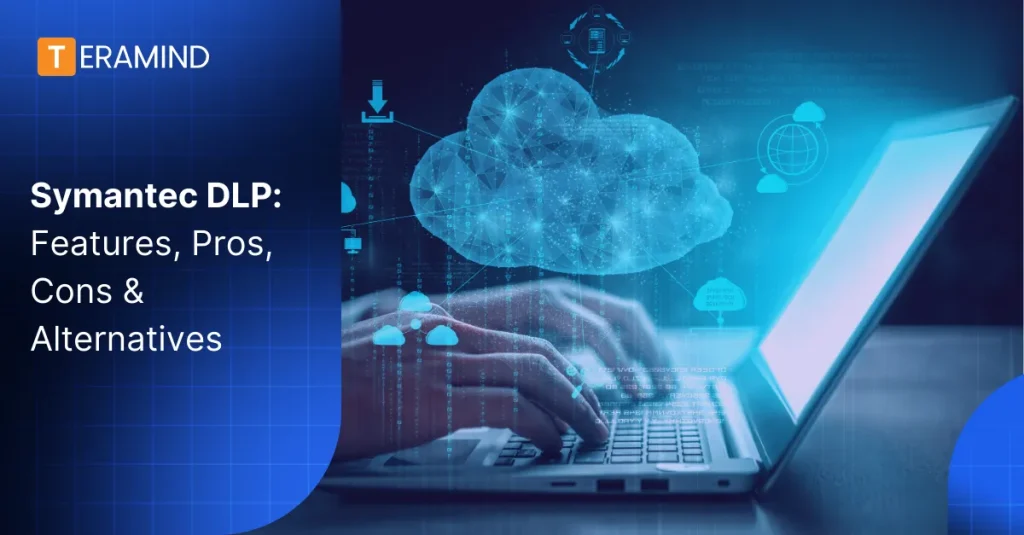Data security is a critical concern for many organizations these days. As data breaches and cyber threats continue to rise, companies need effective solutions to protect their sensitive information.
Enter Symantec’s Data Loss Prevention (DLP), a data protection platform designed to help businesses identify, track, and secure their important data across multiple channels, such as endpoints, networks, storage systems, and cloud applications.
Pros and Cons of Symantec DLP
| Pros | Cons |
| Comprehensive data protection | Complex implementation |
| Advanced policy management | Resource-intensive |
| Multi-channel coverage | Limited monitoring capabilities |
| Robust reporting capabilities | Potential performance impact |
| Scalability for enterprise use | No remote desktop control |
Detailed Features Breakdown
Data Discovery and Classification
Symantec DLP’s data discovery and classification feature forms the foundation of its protection strategy.
- Data Loss Prevention: Symantec DLP offers complete discovery, monitoring, and protection capabilities for data in use across multiple channels, including email, cloud applications, network protocols, external storage devices, and virtual desktops and servers.
- Content-aware scanning: Analyzes file content to identify sensitive information.
- Pattern matching: Uses regular expressions and algorithms to detect specific data patterns.
- Real-time Alerts: Symantec DLP generates real-time alerts and notifications when potential data loss incidents are detected, enabling quick response and remediation.
- Machine learning classifiers: Employs AI to improve accuracy in data classification.
- OCR & Document Matching: Symantec DLP utilizes optical character recognition (OCR) and document matching techniques to detect sensitive data within images and scanned documents.
Disadvantages
While powerful, the data discovery and classification feature can face challenges in accurately identifying all sensitive data, especially in unstructured formats. This may lead to false positives or missed detections in some cases. Additionally, the initial setup and fine-tuning of classification rules can be time-consuming and require ongoing adjustments as data patterns evolve.
From a cost perspective, organizations may need additional storage and processing power to handle the extensive scanning and classification processes, particularly in large-scale deployments. User experience can also be impacted, as the scanning process may slow down file access times, potentially affecting productivity in time-sensitive environments.
Policy Management and Enforcement
Symantec DLP offers a centralized policy management system to define and enforce data protection rules across the organization.
- Customizable policy templates: Pre-built templates for common compliance requirements.
- Granular control: Ability to create highly specific rules based on various criteria.
- Real-time policy enforcement: Immediate action on policy violations.
Disadvantages
While the policy management system is robust, it can become unwieldy in complex environments. Creating and maintaining a large number of policies can be challenging, potentially leading to conflicts or oversights. Technical challenges may arise when integrating policies across diverse systems and applications, especially in heterogeneous IT environments.
Maintaining an effective policy management system costs beyond the initial setup, requiring ongoing resources for policy updates, testing, and refinement. From a user perspective, strict policy enforcement may sometimes hinder legitimate work processes, necessitating a delicate balance between security and usability.
Incident Management and Reporting
This feature provides a comprehensive view of DLP events and violations across the organization.
- Centralized incident dashboard: Single-pane-of-glass view for all DLP incidents.
- Customizable reports: Ability to generate tailored reports for different stakeholders.
- Automated incident response: Predefined workflows for handling common violation types.
Disadvantages
The incident management system can generate a high volume of alerts, potentially leading to alert fatigue among security teams. Prioritizing and effectively responding to all incidents can be challenging, especially in large organizations with complex data flows.
From a technical standpoint, integrating the incident management system with other security tools and SIEM solutions may require additional configuration and maintenance efforts. Cost-wise, organizations may need to allocate significant resources to staff a team capable of effectively managing and responding to the volume of incidents generated.
Without proper training and well-defined incident response procedures, the user experience for security analysts can be overwhelming, potentially leading to longer resolution times for critical issues.
Endpoint Protection
Symantec DLP extends data protection to individual endpoints, ensuring that sensitive information remains secure even when devices are off the corporate network.
- Device control: Manages access to USB drives, printers, and other peripherals to prevent unauthorized data transfers.
- Application control: Restricts the use of potentially risky applications that could lead to data leakage.
- Offline protection: Continues to enforce policies even when endpoints are not connected to the corporate network.
Disadvantages
Endpoint protection can sometimes impact system performance, especially on older or less powerful devices. Additionally, stringent controls may limit user flexibility and productivity, particularly for employees who require access to various applications or external devices for their work.
Where Teramind Excels
Let’s compare Symantec to Teramind — where you can decide what matters.
- User Activity Monitoring: Teramind offers more comprehensive user activity tracking, providing detailed insights into employee behavior and productivity.
- Insider Threat Detection: Advanced analytics and behavior profiling make Teramind particularly effective at identifying and mitigating insider threats.
- Productivity Optimization: Teramind’s features extend beyond security, offering tools for workforce productivity analysis and improvement.
- User-Friendly Interface: Teramind is known for its intuitive and easy-to-use dashboard, reducing the learning curve for administrators.
- Flexible Deployment Options: Teramind offers a wider range of deployment options, including a fully on-premise solution for organizations with strict data sovereignty requirements.
Live Session Monitoring
Teramind provides real-time session monitoring capabilities, allowing administrators to view user activities as they happen. This feature enables immediate intervention in case of suspicious behavior or policy violations. Live session monitoring also serves as a powerful deterrent against malicious insider actions, as users are aware that their activities may be observed in real-time.
The ability to record and playback user sessions offers valuable context for incident investigations. It helps security teams understand the full sequence of events leading up to a data loss incident. This level of detail is particularly useful for forensic analysis and can provide crucial evidence in legal proceedings.
Behavioral DLP, Analytics and Anomaly Detection
Teramind’s advanced behavioral analytics engine sets it apart from traditional DLP solutions. By establishing baseline behavior patterns for users and departments, Teramind can quickly identify anomalies that may indicate potential security risks or productivity issues.
This proactive approach to threat detection allows organizations to address potential problems before they escalate into serious incidents. The system’s ability to learn and adapt to changing user behaviors over time ensures that it remains effective in dynamic work environments. Additionally, the anomaly detection capabilities can help organizations uncover inefficient processes or workflow bottlenecks, contributing to overall operational improvements.
Why You Should Consider Teramind
- Comprehensive Visibility: Teramind offers unmatched insights into user activities, providing a holistic view of data interactions and potential risks.
- Proactive Threat Prevention: The combination of real-time monitoring and behavioral analytics enables organizations to prevent data loss incidents before they occur.
- Productivity Enhancement: Teramind’s features extend beyond security, offering valuable tools for improving workforce productivity and operational efficiency.
- Scalability and Flexibility: With its range of deployment options and customizable features, Teramind can adapt to the needs of organizations of all sizes and industries.
- Lower Total Cost of Ownership: Teramind’s easy implementation process can lower training and maintenance costs than more complex DLP solutions.
By choosing Teramind, organizations can benefit from a more comprehensive approach to data protection that addresses both security and productivity concerns, ultimately leading to a stronger overall security posture and improved operational efficiency.


